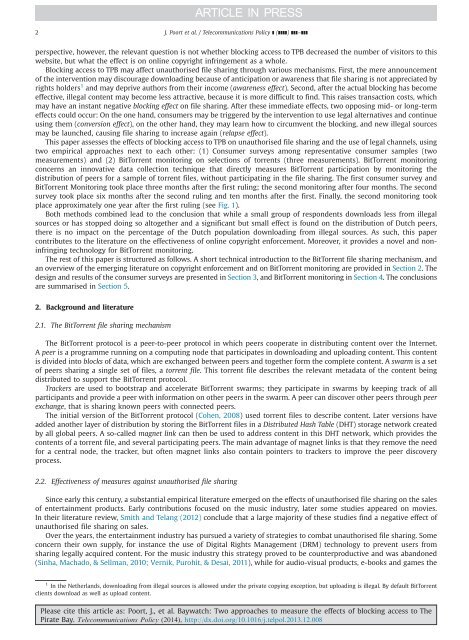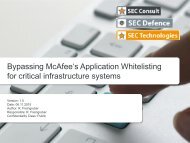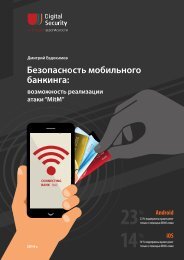1401-Baywatch
1401-Baywatch
1401-Baywatch
Create successful ePaper yourself
Turn your PDF publications into a flip-book with our unique Google optimized e-Paper software.
2<br />
J. Poort et al. / Telecommunications Policy ] (]]]]) ]]]–]]]<br />
perspective, however, the relevant question is not whether blocking access to TPB decreased the number of visitors to this<br />
website, but what the effect is on online copyright infringement as a whole.<br />
Blocking access to TPB may affect unauthorised file sharing through various mechanisms. First, the mere announcement<br />
of the intervention may discourage downloading because of anticipation or awareness that file sharing is not appreciated by<br />
rights holders 1 and may deprive authors from their income (awareness effect). Second, after the actual blocking has become<br />
effective, illegal content may become less attractive, because it is more difficult to find. This raises transaction costs, which<br />
may have an instant negative blocking effect on file sharing. After these immediate effects, two opposing mid- or long-term<br />
effects could occur: On the one hand, consumers may be triggered by the intervention to use legal alternatives and continue<br />
using them (conversion effect), on the other hand, they may learn how to circumvent the blocking, and new illegal sources<br />
may be launched, causing file sharing to increase again (relapse effect).<br />
This paper assesses the effects of blocking access to TPB on unauthorised file sharing and the use of legal channels, using<br />
two empirical approaches next to each other: (1) Consumer surveys among representative consumer samples (two<br />
measurements) and (2) BitTorrent monitoring on selections of torrents (three measurements). BitTorrent monitoring<br />
concerns an innovative data collection technique that directly measures BitTorrent participation by monitoring the<br />
distribution of peers for a sample of torrent files, without participating in the file sharing. The first consumer survey and<br />
BitTorrent Monitoring took place three months after the first ruling; the second monitoring after four months. The second<br />
survey took place six months after the second ruling and ten months after the first. Finally, the second monitoring took<br />
place approximately one year after the first ruling (see Fig. 1).<br />
Both methods combined lead to the conclusion that while a small group of respondents downloads less from illegal<br />
sources or has stopped doing so altogether and a significant but small effect is found on the distribution of Dutch peers,<br />
there is no impact on the percentage of the Dutch population downloading from illegal sources. As such, this paper<br />
contributes to the literature on the effectiveness of online copyright enforcement. Moreover, it provides a novel and noninfringing<br />
technology for BitTorrent monitoring.<br />
The rest of this paper is structured as follows. A short technical introduction to the BitTorrent file sharing mechanism, and<br />
an overview of the emerging literature on copyright enforcement and on BitTorrent monitoring are provided in Section 2. The<br />
design and results of the consumer surveys are presented in Section 3, and BitTorrent monitoring in Section 4. The conclusions<br />
are summarised in Section 5.<br />
2. Background and literature<br />
2.1. The BitTorrent file sharing mechanism<br />
The BitTorrent protocol is a peer-to-peer protocol in which peers cooperate in distributing content over the Internet.<br />
A peer is a programme running on a computing node that participates in downloading and uploading content. This content<br />
is divided into blocks of data, which are exchanged between peers and together form the complete content. A swarm is a set<br />
of peers sharing a single set of files, a torrent file. This torrent file describes the relevant metadata of the content being<br />
distributed to support the BitTorrent protocol.<br />
Trackers are used to bootstrap and accelerate BitTorrent swarms; they participate in swarms by keeping track of all<br />
participants and provide a peer with information on other peers in the swarm. A peer can discover other peers through peer<br />
exchange, that is sharing known peers with connected peers.<br />
The initial version of the BitTorrent protocol (Cohen, 2008) used torrent files to describe content. Later versions have<br />
added another layer of distribution by storing the BitTorrent files in a Distributed Hash Table (DHT) storage network created<br />
by all global peers. A so-called magnet link can then be used to address content in this DHT network, which provides the<br />
contents of a torrent file, and several participating peers. The main advantage of magnet links is that they remove the need<br />
for a central node, the tracker, but often magnet links also contain pointers to trackers to improve the peer discovery<br />
process.<br />
2.2. Effectiveness of measures against unauthorised file sharing<br />
Since early this century, a substantial empirical literature emerged on the effects of unauthorised file sharing on the sales<br />
of entertainment products. Early contributions focused on the music industry, later some studies appeared on movies.<br />
In their literature review, Smith and Telang (2012) conclude that a large majority of these studies find a negative effect of<br />
unauthorised file sharing on sales.<br />
Over the years, the entertainment industry has pursued a variety of strategies to combat unauthorised file sharing. Some<br />
concern their own supply, for instance the use of Digital Rights Management (DRM) technology to prevent users from<br />
sharing legally acquired content. For the music industry this strategy proved to be counterproductive and was abandoned<br />
(Sinha, Machado, & Sellman, 2010; Vernik, Purohit, & Desai, 2011), while for audio-visual products, e-books and games the<br />
1 In the Netherlands, downloading from illegal sources is allowed under the private copying exception, but uploading is illegal. By default BitTorrent<br />
clients download as well as upload content.<br />
Please cite this article as: Poort, J., et al. <strong>Baywatch</strong>: Two approaches to measure the effects of blocking access to The<br />
Pirate Bay. Telecommunications Policy (2014), http://dx.doi.org/10.1016/j.telpol.2013.12.008i






